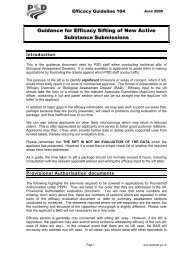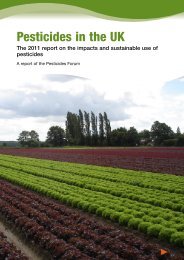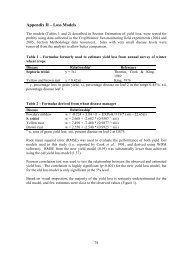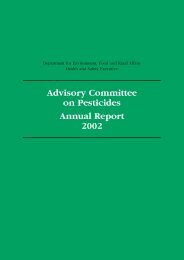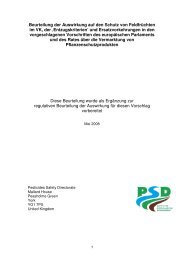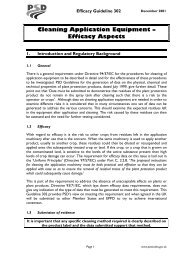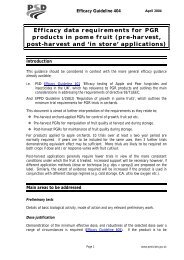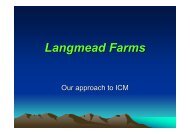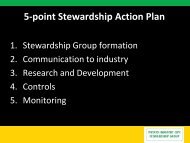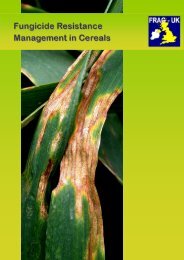Advisory Committee on Pesticides Annual Report 2001
ACP Annual Report 2001 - Pesticides Safety Directorate
ACP Annual Report 2001 - Pesticides Safety Directorate
Create successful ePaper yourself
Turn your PDF publications into a flip-book with our unique Google optimized e-Paper software.
<str<strong>on</strong>g>Advisory</str<strong>on</strong>g> <str<strong>on</strong>g>Committee</str<strong>on</strong>g> <strong>on</strong> <strong>Pesticides</strong> <strong>Annual</strong> <strong>Report</strong> <strong>2001</strong><br />
<strong>on</strong>e-third, 32 percent, of cider apples and perry pears; 22 percent of plums;<br />
and seven percent of cherries received no pesticides.<br />
Fungicides and pruning paints accounted for 60 percent of the total pesticidetreated<br />
area of orchard crops grown in Great Britain in 2000, insecticides<br />
12 percent, herbicides 11 percent, growth regulators ten percent, sulphur two<br />
percent, urea two percent, acaricides <strong>on</strong>e percent and acaricide/insecticides,<br />
biological c<strong>on</strong>trol agents, tar oil/acids, all less than <strong>on</strong>e percent each. In<br />
c<strong>on</strong>trast, fungicides and pruning paints accounted for 50 percent of the total<br />
weight of pesticide active substances applied, herbicides 12 percent, sulphur<br />
12 percent, insecticides ten percent, tar oil/acids ten percent, urea five percent<br />
and growth regulators <strong>on</strong>e percent.<br />
70<br />
The principal fungicide formulati<strong>on</strong>s were captan (20 percent), myclobutanil<br />
(14 percent), dithian<strong>on</strong> (13 percent), penc<strong>on</strong>azole (nine percent), pyrifenox<br />
(six percent) and bupirimate (six percent). By weight applied, however, while<br />
captan was still the most extensively used formulati<strong>on</strong>, it accounted<br />
for 47 percent of all fungicide use, while dithian<strong>on</strong> comprised 15 percent,<br />
captan/penc<strong>on</strong>azole ten percent, dodine eight percent and mancozeb<br />
seven percent.<br />
The organophosphates were the most extensively used insecticides,<br />
accounting for 60 percent of the insecticide-treated area, followed by the<br />
carbamates, 16 percent, ‘other insecticides’, mainly the juvenile horm<strong>on</strong>e<br />
analogue fenoxycarb, 15 percent, pyrethroids, six percent and the<br />
benzoylureas, two percent. Five formulati<strong>on</strong>s accounted for approximately<br />
90 percent of the total insecticide-treated area of all orchard crops:<br />
chlorpyrifos 54 percent; fenoxycarb 15 percent; pirimicarb 12 percent;<br />
cypermethrin five percent and carbaryl four percent, which was also used<br />
specifically as a fruit thinning agent <strong>on</strong> apples (see growth regulators).<br />
Chlorpyrifos accounted for 69 percent of the total weight of insecticides<br />
applied and carbaryl, used <strong>on</strong> four percent of the total insecticide area,<br />
accounted for a further 11 percent.<br />
The most extensively used herbicide formulati<strong>on</strong>s were glyphosate, accounting<br />
for 28 percent of the area treated, simazine, 14 percent, glufosinateamm<strong>on</strong>ium,<br />
nine percent, 2,4-D/dichlorprop/MCPA/mecoprop, eight percent<br />
and amitrole, seven percent. In terms of weight applied, glyphosate accounted<br />
for 30 percent of the total, simazine 14 percent, 2,4-D/dichlorprop/MCPA/<br />
mecoprop, ten percent, amitrole, eight percent, and dicamba/MCPA/mecoprop,<br />
eight percent.




